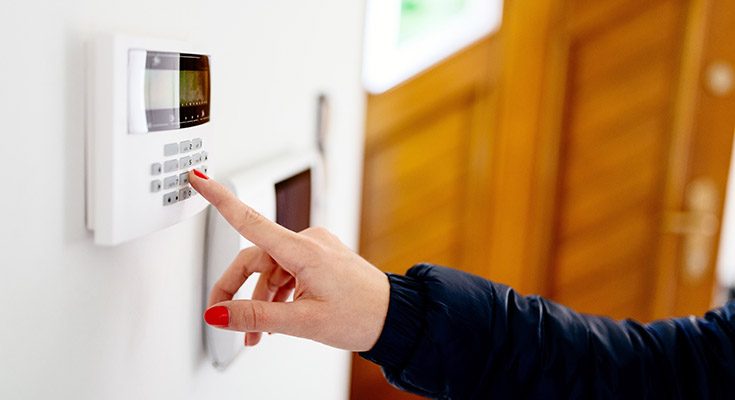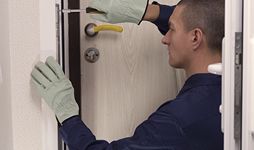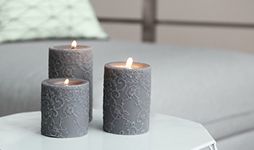Making sure your home is secure is a big part of keeping unwanted visitors out. Between January and June 2023, 7% of all claims made to MORE THAN home insurance were for theft from the home. This highlights the importance of having effective security measures in place.
In this guide, you'll discover the different options available to help make your home safer and keep your insurance valid.

Understanding your daily routines
Burglars seek out easy entry points and aim for quick getaways. Therefore, installing devices that hinder their progress or draw attention to their actions will discourage them from targeting your home.
Burglars often study your daily patterns before attempting a break-in. Additionally, many burglaries occur in the early-to-mid afternoon when people are at school or work. Another common target is when you're away on holiday.
Secure your doors
Doors are a common way for burglars to get into homes, so it's important to have good locks.
Burglars may attempt to use a side or back door as they are less likely to be seen there. That's why it's important to add locks to these doors. Consider using a mortice lock for the back door and locking bolts at the top and bottom of patio doors.
Look for mortice locks with the British Standard Kitemark. These locks are embedded within the door, not just attached to the surface.
The police recommend a 5-lever mortice lock for wooden doors. These locks catch the bolt and prevent it from moving if someone tries to pick it.
Lock your windows
It’s as important to make sure your windows are secure too. Ideally windows should have locks that you can open with a key. If they have locks in the frame as well as the handle, this will make them even more burglar-proof. Don't forget about loft hatches or skylight windows either. Laminated and double-glazed windows are harder for intruders to break without making noise.
Here are some other ways to make your windows safer:
- Window security film: this special film prevents windows from shattering if someone tries to break in
- Window bars: these are simple but effective. Bars help stop break-ins and make it harder for someone to get out of certain points in your home
- Glass break sensors: these sensors use sound technology to detect the noise of breaking glass, alerting you if someone is trying to enter your property
Set up a security system
Home security systems help protect your home from break-ins. They work by using a main control system that connects to sensors placed at different entry points in your home. These sensors are connected to an alarm system.
There are a few types of home security systems:
- Electric current alarm: this alarm is often installed when a new house is built. It makes a beeping sound when certain doors or windows are opened
- Monitored system: this system sends an alarm message to you, your security agency, or the police when it detects a break-in
- Un-monitored system: this system sets off an alarm to alert you or your neighbours if there's a break-in. But, it doesn't send alerts to the police or your security agency
These home security systems provide different levels of protection, and it's important to choose the one that suits your needs.
Installation of your home security system
When it comes to installing a security system for your home, you have two options: professional installation or DIY installation. Professional installation provides the benefit of having your property assessed by experts, but it can be more expensive. DIY installation could be a more cost-effective choice, especially for smaller properties, and gives you the flexibility to make changes to the system yourself.
Install a home security camera
Home security cameras keep an eye on your house all the time and let you know if anything suspicious happens.
These cameras also record footage that can be given to the police if something goes wrong.
You can choose between wired and wireless home security cameras, and you can watch the footage on devices like TVs, tablets, or smartphones.
Quality varies, and some come with extra features like night vision and motion detection.
The more expensive cameras have tough casings that help protect them from vandals or intruders.
Setting up smart lighting
Smart lights are a great way to improve your home security. They detect movement and light up your property, which helps scare away thieves who like to work in darkness. You can also program them to turn on and off at specific times, making it hard for thieves to know if someone is home.
Inside your home, you can use smart lights to mimic your usual routines when you're away. You can control them through a phone app or connect them to security cameras with built-in motion sensors.
Outside, you can place smart lights around your property to light up pathways, driveways, porches, and gardens. There are many options to choose from, like lampposts or floodlights.
By using smart plugs for lamps, smart bulbs for hallways and porches, or exterior smart lighting, your home will be well-lit, making it less appealing to thieves.
Secure Wi-Fi networks
It's important to protect your Wi-Fi network from thieves who can steal your personal information. They use advanced technology to guess passwords and access your data.
Here are some tips to secure your Wi-Fi network:
- Create a strong and unique password
- If your router has a firewall, turn it on
- Change the name of your network to something unique
- Keep your router's software up to date
- Use encryption and make sure your network is set to WPA2 Personal
Hide your valuables
To help protect your valuables from burglars, it's important to keep them hidden in safe places. Burglars want to work quickly, so they search obvious spots like drawers and cupboards. If you don't have a strong home security system, creating a few hiding places for your valuable items is a good idea.
However, it's important not to create too many hiding spots, as you might forget where they are. Choose 2 or 3 secure spots around your home for this purpose. Keep in mind that thieves usually check living rooms and bedrooms first.
Best places to hide valuables:
- In and around your kitchen, such as in empty dishwasher boxes or empty bottles of cleaning supplies
- Within a hollowed out book in a bookcase
- False pipes and vents
- False wall sockets
Worst places to hide valuables:
- Under a mattress or bed
- In the freezer
In a drawer such as a sock drawer
- In vases or flower-pots
- In toilet cisterns
Invest in a home safe
Having a safe at home could be a smart choice if you have valuable items that are hard to replace and mean a lot to you. Make sure the safe you choose is fireproof and waterproof, to help keep your precious belongings protected if you experience a flood or fire in the home.
Hiding your home safe
You can hide your safe behind a bookshelf, heavy piece of furniture, or under the stairs.
An even better option is bolting your safe to the floor, making it almost impossible to move without causing a lot of disturbance.
Avoid putting the safe in the main bedroom, as that's where thieves usually look first. And don’t install them in garages or outside buildings, as they provide less protection.
Keeping your keys safe
It's important to keep your keys in a secure place at all times. If you leave your keys in obvious spots like behind the letterbox or under a flowerpot or doormat, it can make it easier for burglars to enter your home. Insurers will check for carelessness like this when assessing burglary claims. Instead, if you need to leave a spare key for friends or family, it's better to give it to a trusted neighbour.
Home insurance and home security
Insurance companies usually need you to have a certain level of home security before they provide cover. This could include having deadlocks on external doors, such as 5-lever mortice locks that meet the BS3621 standard.
Some insurers may also need you to have locks on accessible windows, like those on the basement and ground floor, or that are reachable by climbing.
By taking steps to improve your home's security, you can help protect your home and reduce the likelihood of making insurance claims. This, in turn, can help keep insurance costs down.
Protect yourself and your home
Securing your property is important to protect your home, but having the right insurance cover will give you added peace of mind.



